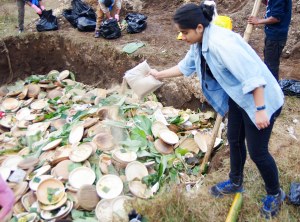Rishab Khanna*
What if I said that the floods in Chennai, crazy storm in Sweden, and the upsurges in the Middle East have only one long-time solution?
Some might say that this is absurd, but I believe that not being able to see the connections and the systemic loopholes is absurd. Untamed thirst for natural resources, coupled with excessive carbon emissions, has created major crises in many of the economies.
It is no surprise that the developing countries and especially Least Developed Countries have most to lose. The developed countries have been built on the colonial past, during which they not only exploited resources of the developing countries, but also left a lasting imprint on the social and ecological systems, in a way that has continued the neocolonial exploitation. Many of the developing countries have been controlled through dictatorial regimes which have been often imposed on them by the west.
According to my colleague Peter Riddle, “Whenever we (the Western coalition) have supported a particular group in West Asia to counter another group, that group has become a monster. We supported Israel, and that alienated the whole Arab and Muslim world. We supported the Taliban in Afghanistan to oust the Soviets, and it became Al-Qaeda, which spawned ISIS”.
However, the G20, or the group of developed nations refused to take responsibility of the historical debt, at the same time, they continue to misguide the world with the arbitrary figure of the GDP. Do more products and services in the economy mean a better life, improvement in the ecological system? Not necessarily. On the contrary, it could mean more war and increase in destruction of natural resources. No wonder most countries do not want to stop climate change, or stop the oil trade with ISIS, as it affects the GDP of our world.
Don’t we all wonder, why are we obsessed with quantifying the GDP, when it has not the relation with the quality of life?
In fact, in a survey done by Accenture in Germany and Austria, almost 80 to 90 percent of the respondents said that they wanted a change in the economic system, and almost 67 percent said that they would like to review GDP as the highest goal of the economy. Then what are we waiting for?
Currently the leaders from emerging countries like India believe that mitigating climate change is a huge sacrifice for us.
President Pranab Mukherjee recently said, “India faces a huge responsibility and challenge in meeting its developmental requirements while remaining committed at the same time to clean energy.” What If there are no contradictions in these goals. What if development goals are only possible with clean energy, with minimal impact on health and environment?
Imagine that the new climate target of the COP 21 agreement for limiting global warming to less than 1.5 degrees of warming becomes part of the common good product of nation, making GDP (Gross Domestic Product) irrelevant. An increase in the common good product would mean reducing inequality, reduction in emissions and more jobs.
At the corporate level, an increase in the common good balance sheet, would mean fair wages, reduction in emissions of carbon dioxide and no revenue coming from the sales of weapons or on patents of live forms.
Our financial return would be the common good return, where investments are creating social impact rather than just blind profit.
The founder of the Economy for the Common Good, Christian Felber, says that working for the common good as the highest goal of the economy is nothing new, as most constitutions of democratic countries refer to the same; however this has not been given the attention it deserves.
The COP 21 agreement is a historical treaty for us, as 196 countries have committed to the path of climate justice, however the political reality is often shaped by the economic rhetoric of blind growth, without creating the right framework for a transparent market which would promote ethical and sustainable production, and until we turn the economy back to its feet, we will struggle to achieve the climate target, 17 SDGs or even peace in the world.
(Rishab is former Board Member of Indian Youth Climate Network -IYCN and is currently working as Programm associate for Ethical Leadership and Sustainable Living at Initiatives of Change, Sweden)



